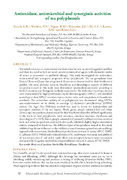| dc.description.abstract | Microbial resistance to conventional antibiotics has become an increasing global problem
and there is a need to find out novel, potent antimicrobial agents with alternative modes
of action as accessories to antibiotic therapy. This study investigated the antioxidant,
antimicrobial and synergistic properties of tea polyphenols. The tea germplasm from
Kenya, China and Japan that are grown in Kenya were characterised for their biochemical
profiles. The total phenolic content, theaflavins and thearubigins content of different
tea products used in this study were determined spectrophotometrically according to
Folin-Ciocalteus and flavognost methods respectively. The individual catechin contents
were characterised by high performance liquid chromatography (HPLC) and identified
according to their HPLC retention times, elution order and comparison with authentic
standards. The antioxidant activity of tea polyphenols was determined using UV-Vis
spectrophotometer on its ability to scavenge 2,2-diphenyl-1-picrylhydrazyl (DPPH)
radical. The Agar Disc Diffusion method was used to screen for antimicrobial and
synergistic activities of the tea liquors. Black, green, purple coloured leaf and white
(silvery tips) tea products characterised for their biochemical profiles differed significantly
in the levels of total polyphenols, total catechins, catechins fractions, theaflavins and
thearubigins (P ≤ 0.05). Green, purple coloured leaf (aerated) and black tea from terminal
buds and white tea products analysed in this study exhibited slightly higher antioxidant
activity compared to black tea. The different types of tea products assayed in this study
exhibited significant influence on the inhibition zone diameters against bacteria and fungi
exposed to the tea extracts. Methicillin and penicillinase resistant S. aureus ATCC 25923,
C. albicans ATCC 90028 and a clinical isolate of C. neoformans were more susceptible to all tea extracts than E. coli and S. typhi. There was synergism between most tea extracts and penicillin G against methicillin and penicillinase resistant S. aureus ATTC 25923. | en_US |
